





Tree aloes are some of the most magnificent of all the succulents and can be awesome and imposing landscape statements. Most of the branching tree aloes are exceptionally neat and tidy-looking plants and are some of the most useful and valuable plants for use in xeriscape landscapes throughout the arid, warmer climates of the world. The following article is a brief introduction to some of these aloes, including some cultivational information and photos to aid in helping identify these plants in the nursery as well as in botanical gardens and private landscapes.
As was the case with non-branching tree aloes discussed in part 1, most branching tree aloes are also from South Africa. There are a few from other African countries but some of those are just too rare for purposes of an introductory article. As a group these aloes, in general, seem a bit less cold hardy than the non-branching aloes, and are also a bit less adapted to pot life (most get too large, eventually), too, so their use is a bit more limited. None of the branching aloes retain skirts of dead leaves, as do most of the non-branching aloes. And all the ones discussed below bloom in fall to winter. These trees are mostly grown for their impressive shapes and leaves, not their flowers, unlike is the case with some of the non-branching aloes. Some of these are the most impressive of all the aloes and if one has the space and climate to grow them, one should at least consider these as possible landscape or specimen trees.
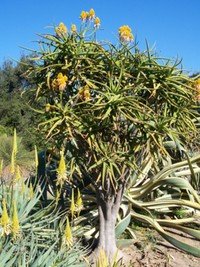 This is a tree in Huntington Gardens, California presently identified as Aloe 'Medusa'... it was thought at first to be Aloe eminens, then a form of Aloe barberae. Now who knows. There are still a lot of aloes out there that need studying... and this would be a great one to add to one's landscaping options!
This is a tree in Huntington Gardens, California presently identified as Aloe 'Medusa'... it was thought at first to be Aloe eminens, then a form of Aloe barberae. Now who knows. There are still a lot of aloes out there that need studying... and this would be a great one to add to one's landscaping options!
Aloe barberae (aka bainsii- Giant Tree Aloe)- this is the big daddy of them all. Few succulents of any sort attain the massive width or height of this species. In the wild it is an impressive tree, but in captivity, where it can be well watered and fertilized, it can grow into a magnificent giant. Probably 40' is its maximum height, but some plants can have branches that spread nearly as wide. Well watered trees can develop massive, caudiciform-like trunks over 10' in diameter. Like most of the branching tree aloes, this is a self-cleaning tree, meaning the dead leaves fall off as they die. The bare trunk of a mature Aloe barberae has a rough bark, though younger plants have wonderfully smooth trunks. This is a fast growing aloe- there are few, if any, faster- and it grows as a solitary, unbranching tree sometimes up to 10' (but usually less) before dichotomously branching (basically 'splitting' or dividing into two growing centers). Then, as it matures, it divides/branches more and more frequently until a large, often half-dome-shaped head of deep green succulent leaves develops, supported by dozens of short, thick branches. The trunks of these branching aloes widen each year, unlike the case with non-branching aloes, which have trunks that pretty much stay the same diameter once they develop. The leaves of this species are long, deeply channeled, and rubbery in texture, with only small, whitish, somewhat blunt teeth along the margins. Younger plants with solitary trunks have very large leaves, up to 4' long. But as the trees age, the leaf size shrinks, and mature plants have leaves about half the length as the young ones do. Adult trees have somewhat abbreviated rosettes of only 10-15 leaves, but younger trees can have 20-30, or more, massive leaves per rosette. Flowers are an ornamental peach color and tend to grow horizonatally or vertically with cylindrical racemes up to only about a foot in length.
Aloe barberae is not one of the more cold hardy aloes, being damaged severely at temps below 28F, and young plants are often killed outright by temps that would hardly touch a non-branched aloe species. Though most older plants will recover from a frost, they tend to look unsightly for 1-2 years. But it is not a tree that appreciates growing in shade, so frost protection is rarely an option. So it is best to grow this tree where severe frosts are rare, or it will always be struggling to recover, and eventually rot. Other than frost, this is a pretty carefree plant, tolerating a wide variety of soils and watering schemes (from none at all, to excessive) and hot, blasting sun or winds hardly phase it. This species is not hard to find, and often shows up at retail nurseries for a reasonable cost. A one gal plant will usually grow into a 15 gal plant in less than 2 years, so one can save money and get this tree small- it will be huge soon enough! There are a few excellent hybrids of this species in cultivation: Aloe 'Goliath' (Aloe barberae x Aloe vaombe) and Aloe 'Hercules' (Aloe barberae x Aloe dichotoma). Both are excellent landscape plants and available at some specialty nurseries.
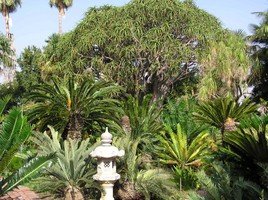 This massive specimen is growing in a private garden and probably gets more water than most aloes do- it is over 10' in diameter at its base
This massive specimen is growing in a private garden and probably gets more water than most aloes do- it is over 10' in diameter at its base
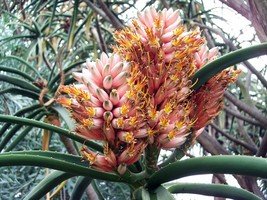 Flowering adult plants in Huntington Gardens, California
Flowering adult plants in Huntington Gardens, California
 Winter flower, southern California
Winter flower, southern California
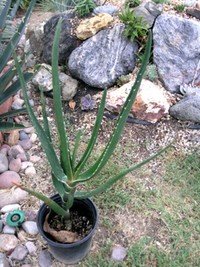 This one gallon seedling, under the right conditions, can be a trunking tree over 10' tall in less than 10 years
This one gallon seedling, under the right conditions, can be a trunking tree over 10' tall in less than 10 years
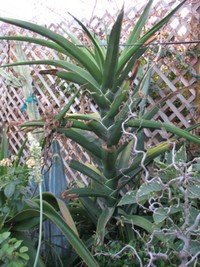 this plant is showing some cold damage from frost a few months earlier- also shows the growth pattern of a tree before splitting begins
this plant is showing some cold damage from frost a few months earlier- also shows the growth pattern of a tree before splitting begins
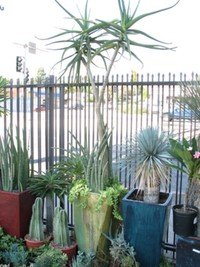 used as a potted plant- young branching Aloe barberae. This will probably outgrow this pot in 2-3 years
used as a potted plant- young branching Aloe barberae. This will probably outgrow this pot in 2-3 years
Aloe dichotoma (Quiver Tree)- this aloe is probably one of the most recognizable landscape aloes and is nearly a symbol of southwestern xeriscape landscaping. It has ornamentally colored pale turquoise to pale sea-green leaves and a light brown to yellow-tan trunk. It is nearly the cliche colors of the southwest, too: turquoise and yellow-orange. It can grow to about 15' but many plants never reach that height. As a young plant it is a moderately fast grower, but then it slows down a lot as it matures, tending to put most of its energy in girth and branching. Young plants with a solitary trunk start out as a stack of slightly spirally arranged leaves, up to 5' tall. But soon after these plants branch (dichotomously, of course- hence the name) and the rosettes decrease in number from 30 or more leaves to often less than half that. Each rosette consists of 10-15 stiff, thick, 6"-12" long and 2"-4" wide straight to slightly curved leaves. The leaves are lined with very small, closely spaced white to yellowish teeth. The trunk of this plant is very ornamental, looking somewhat like a flagstone wall, with large, flat spaces and narrow crevices of 'grout' in between. The rough trunk slowly turns into very polished, smooth branches, completely devoid of any dead leaves. Flowers occur in fall to early winter and are brilliant yellow. Inflorescences are short, slightly branched and have open, cylindrical racemes. Aloe ramosissima, a species many consider just a form of Aloe dichotoma, has identical flowers.
Drought is not a problem for this species and it seems to thrive on lack of water. However, as long as it's grown in very well draining soil, it does seem to tolerate a variety of watering schemes fairly well, rotting only if grown in heavy clay soils or watered extremely heavily. Clay soils seem to retard healthy root development, which in turn tends to stunt these plants, making them grow more slowly with smaller crowns, less branches and prone to falling over in high winds. Though less cold sensitive than Aloe barberae, it is still not a super cold hardy aloe, showing moderate leaf damage, usually at the tips, at or below 26F. Younger plants are less resistant to cold damage than older ones. Plants grown in shade seem prone to mealy bug infestation. This is definitely a sun lover. Aloe dichotoma is a very common tree aloe and often sold at retail nurseries. Large plants are costly, but may be worth the $$ as this plant is a good deal slower growing than Aloe barberae.
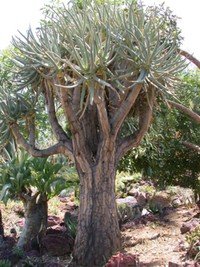 Mature plant in southern California
Mature plant in southern California
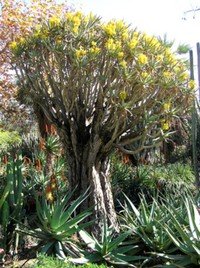 Flowering plant, Hungtinton Gardens, southern California in fall
Flowering plant, Hungtinton Gardens, southern California in fall
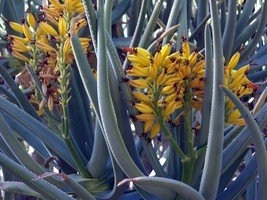 Flowering San Diego plant, October
Flowering San Diego plant, October
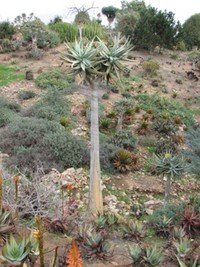 Majestic specimen in private garden, southern California
Majestic specimen in private garden, southern California
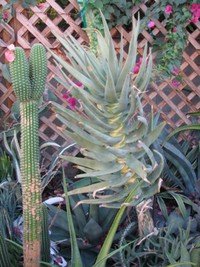 Look of young plant about 5' tall. Note this is one long rosette of leaves (over 30 leaves)- but rosettes shrink to 1/3 that as they branch
Look of young plant about 5' tall. Note this is one long rosette of leaves (over 30 leaves)- but rosettes shrink to 1/3 that as they branch
Aloe eminens- this is a tree aloe from Somalila and is still a very rare plant in cultivation. It looks a lot like Aloe barberae, and a possibly related aloe referred to now as Aloe 'medusa' (see photo near top of article) though what that really is I don't know. Aloe eminens is another huge aloe, growing over 35' tall, though trunk massiveness is not known as so few plants are growing in cultivation no one has tried overwatering one to see if they become monoliths like Aloe barberaes can. These plants have slightly yellower leaves than Aloe barberae and scarlet, red flowers. Cold hardiness information is completely lacking, but it is unlikely to be much superior to these other branching aloes. This plant is so rare even botanical gardens cannot get hold of one, so it is unlikely most aloe enthusiasts will be growing this unless Aloe eminens seed becomes available.
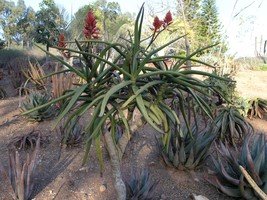 Young tree in private garden, winter, southern California
Young tree in private garden, winter, southern California
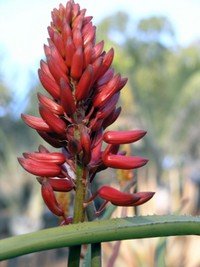 Winter flower detail
Winter flower detail
Aloe mawii- this is the only other branching tree aloe NOT from South Africa to be discussed, and it, too, is a rarity in cultivation. This plant is from central Africa: Tanzania and Malawi (probably has something to do with its name). It is a slow-growing plant, taking many years to form a trunk and grows to about 10' tall, though few if any plants in cultivation are that tall. It tends to branch in a less dichotomous fashion than the other branching tree aloes, and also tends to carry a few dead leaves in an abbreviated skirt below each densely leaved crown. Some might include this in a category of branching, shrubby aloes, but it gets taller than most of those, and forms a trunk at least 6"-10" in diameter. The leaves of this species are arching, heavily armed with teeth along the edges and a light green to pinkish red when cold or during drought. Flowers of this species are uniquely horizontal as well as onesided and solitary. Few, if any, other aloes have flowers like these. The flower color is orange to bright red in winter. This species currently is very difficult to find anywhere, and is basically considered unavailable most of the time.
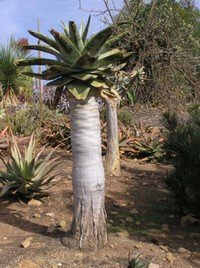 Nicely colored plant in dry winter, flowering, private garden, southern California
Nicely colored plant in dry winter, flowering, private garden, southern California
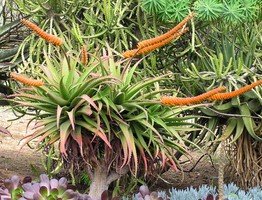 Huntington Garden plant, southern California
Huntington Garden plant, southern California
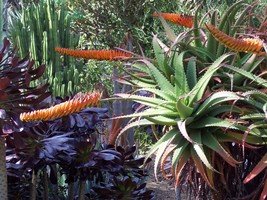 closer shot of flowers on this same plant
closer shot of flowers on this same plant
Aloe pillansii (Giant Quiver Tree)- Some initially confuse this aloe with Aloe dichotoma since it has somewhat similar leaves and trunk. But closer inspection will reveal the leaves are much larger, wider and recurved, and armed with more prominent white teeth. Leaf color varies from light blue to light green. The branches of this species are less 'organized' than Aloe dichotoma and there are far fewer of them. Eventually it also becomes a much taller tree, growing up to 25' or more, with generally less lateral growth than in Aloe dichotoma. However it is a very slow growing tree so plants of that size are indeed rare in cultivation. In fact, this is a pretty rare plant in general, being critically endangered in South Africa and so slow to grow that it is not used much in landscaping. But it is becoming more available so perhaps that will change over the next century. The flowers of this species are similar in color (bright yellow) to Aloe dichotoma and ramosissima, but grow below the leaf crowns, almost pointing downward.
Cold hardiness is less than impressive with Aloe pillansii, and moderate leaf damage occurs at temps below 27F. However most plants recover quickly unless severe freezes are encountered. It is a somewhat finicky species about summer water and seems to prefer being on the drier side then. Rot or root damage can occur from excessive summer watering. It is a sun worshiper and does not grow well in shady conditions. Young plants develop a fat, smooth trunk and do not get a rougher trunk for many decades until they start to branch (most do not branch until fairly tall). Few even branching plants exist in cultivation in US. Seedlings are becoming more readily available from on line sources, and occasionally larger plants will show up at specialty nurseries for very high costs.
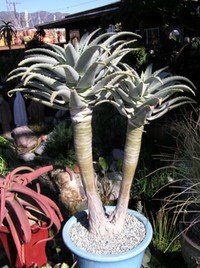 Pair of plants in pot in a nursery (not for sale, unfortunately)
Pair of plants in pot in a nursery (not for sale, unfortunately)
 Wonderfully fat plant in private garden, southern California
Wonderfully fat plant in private garden, southern California
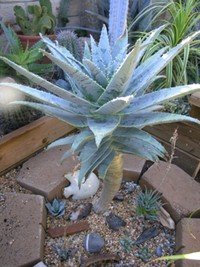 young plant showing leaf structure
young plant showing leaf structure
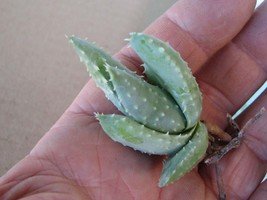 Typical size of mail order plant- how long 'til it trunks?
Typical size of mail order plant- how long 'til it trunks?
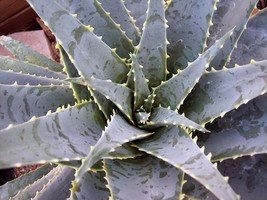 Top view of younger plant
Top view of younger plant
Aloe plicatilis (Fan Aloe)- this is another highly recognized plant having unique leaves and being very commonly available. This species grows to about 18' but takes many many decades to get there (few, if any, plants in cultivation attain that height). These plants start branching very close to the ground and slowly start developing a thick, rough-textured trunk and sturdy branches. The leaves are uniquely flat and rounded at the tips, sort of like rubbery, pale blue-green tongue-depressors (and about that same size). They grow distichously (in a single plane) giving the rosettes the look of a fan (hence the name Fan Aloe). The flowers are less than spectacular in Aloe plicatilis- relatively small solitary inflorescences that arch upward about 2' with thin, very open, sparse racemes of salmon-colored flowers. This is plant grown for it's leaf structure and artful overall presentation. Aloe plicatilis is one of the few branching aloes that does well in pots, at least for many years until it just gets too large.
Cold hardiness is similar to most of the above species with leaf damage noticable at or below 28F, though plants overall seem resistant to dying from freezes unless severe. Leaves that age or die for whatever reason turn black first. Blackened leaves also seem to be a response to underwatering, something that this aloe, at least while young, seems more prone to than any of the other tree aloes. Otherwise it is a pretty care-free plant. This plant is easily found at most nurseries that sell succulents. Even large, 24" box plants are easy to find (but costly).
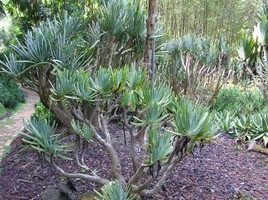 Mature plants are works of art- this one in Lotusland, Santa Barbara, California
Mature plants are works of art- this one in Lotusland, Santa Barbara, California
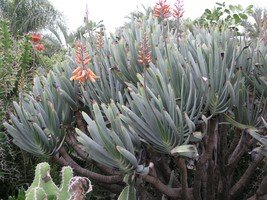 Flowering plant in winter, southern California
Flowering plant in winter, southern California
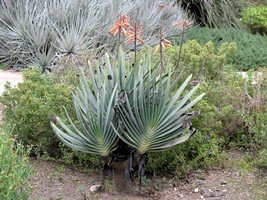 Small elegant plant showing the fan leaves
Small elegant plant showing the fan leaves
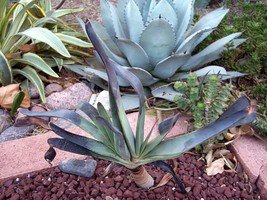 Seedling showing blackened leaves- these from recent frost
Seedling showing blackened leaves- these from recent frost
Aloe ramosissima (Maiden Quiver Tree)- many biologists include this in the same species as Aloe dichotoma, just a different variety. But since many do not, it is listed separately here. The image at the top of the article shows this species next to the larger, trunking Aloe dichotoma. Some do not include this in the tree aloe category since it is much more shrub-like. But its relationship to Aloe dichotoma keeps it here. This plant grows up to about a maximum of 8' tall over all with no main trunk. It seems if all its energy goes into making branches and is the most branched of any aloe species, tree or not. Smaller plants are hard to distinguish from Aloe dichotoma seedlings, but these branch at a very young age and size, while Aloe dichotomas rarely branch below 3' of trunk height. Rosettes of this species are particularly sparse, often consisting of less than 10 stiff, grey-green to pale olive yellow-green narrow leaves 6"-10" long. Leaves have nearly insignificant marginal brownish teeth. Flowers are similar to Aloe dichotoma- bright yellow, open, short cylindrical racemes, the entire inflorescence only being 18"-24" long. Flowers form near the top of the rosettes and grow upright.
Though this plant is considered a variant of Aloe dichotoma, it seems more cold sensitive, showing severe leaf damage below 27F, and often rotting and dying from freezing temps. It also seems to resent overwatering having sensitive roots- this is particularly true in summer. Otherwise is is a fairly easy plant to grow. Unlike most smaller branching aloes, this plant is very difficult to root from branch cuttings, though it is possible. Branches tend to be somewhat hollow and woody in cross-section and often will not form new roots. Aloe ramosissima is a relatively rare plant, but available at most specialty nurseries.
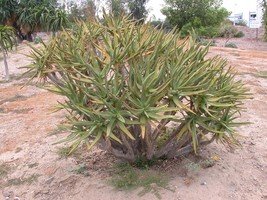 Maturing plant in Fullerton Botanical Gardens, California
Maturing plant in Fullerton Botanical Gardens, California
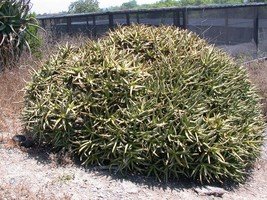 Old plant, UC Irvine botanical gardens, California
Old plant, UC Irvine botanical gardens, California
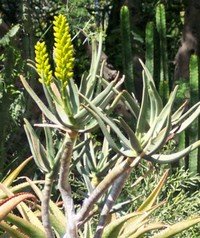 Autumn flowers
Autumn flowers
Branching tree aloes, though a bit less hardy than the non-branching tree aloes, are still magnificent plants and worthy of being the centerpiece in the proper landscape and climate.
Copyright © www.100flowers.win Botanic Garden All Rights Reserved